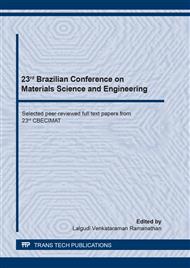p.314
p.319
p.325
p.331
p.337
p.343
p.349
p.354
p.360
Thermal Transformations of the Nickel Laterite Agglomerate Phases and their Metallurgical Influence
Abstract:
In nickel laterite agglomerates from rotary kiln of RKEF process the phases lizardite and/or chrysotile, clinochlore, quartz and hematite were identified. The product contain SiO2 (32.67%), Fe2O3 (24.68%), MgO (21.81%) and NiO (3.30%) as principal components. When thermal treatment were carried out weight differences can be observed where the adsorbed water removed during drying, without phase changes in temperatures ranging from 60°C to 100°C, indicated influence of mineral assemblage. Phase changes and weight loss was observed in calcination with clear crystalline restructuring of the serpentines and clinochlore at 500°C. Above this temperature new phases are crystallized until 820°C, when is formed forsterite and enstatite, provably trevorite and remaining unchanged quartz. There were identified nickel minerals. The nickel occurs in bearing phases as Mg-Ni ion substitution in the crystal structure. On the analyzed conditions might infer that these new phases formed can affect the pyrometallurgical process of reduction.
Info:
Periodical:
Pages:
337-342
Citation:
Online since:
October 2020
Keywords:
Price:
Сopyright:
© 2020 Trans Tech Publications Ltd. All Rights Reserved
Share:
Citation:


